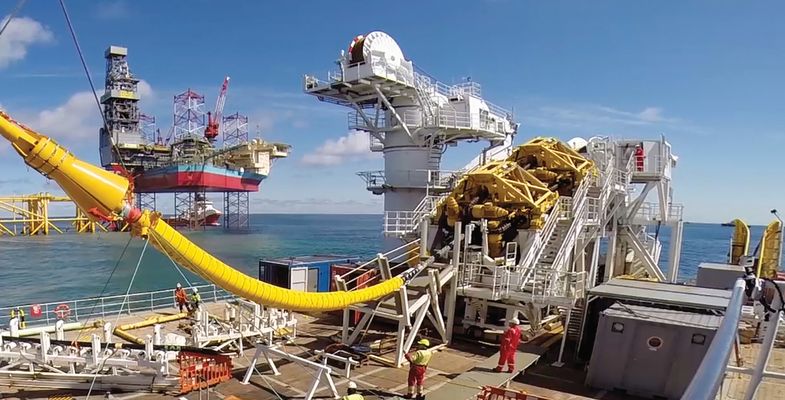ASTM G155 Xenon Arc Weathering Testing of Offshore Cables
The ASTM G155 standard is a critical tool in ensuring that offshore cables and subsea infrastructure can withstand the harsh marine environment. This testing method simulates the effects of ultraviolet (UV) radiation, heat, humidity, and ozone on materials used in these applications. The procedure involves exposing specimens to xenon arc light under controlled conditions to mimic solar radiation.
The ASTM G155 test is particularly important for quality managers and R&D engineers who need to ensure that their products meet the stringent requirements of the energy sector, especially offshores platforms and subsea cables. This testing ensures that materials can maintain their performance over extended periods in harsh environments without degradation.
The process begins with careful sample preparation, where the cable or component is cut into a standard size for exposure to the xenon arc light. The test typically lasts several hundred hours, depending on the desired simulation of real-world conditions. During this time, the samples are continuously monitored and evaluated for changes in color, texture, and overall integrity.
Instrumentation used in ASTM G155 testing includes a Xenon Arc Weatherometer that can simulate various environmental conditions. The equipment is designed to provide consistent and reproducible results, which are crucial for compliance with international standards such as ISO 25789-3:2016.
The test parameters are critical for achieving accurate results. The temperature during the test can be controlled between 50°C and 85°C depending on the specific requirements of the material being tested. Humidity is also a key factor, often maintained at 65% relative humidity to simulate marine conditions.
After the testing period, the samples are thoroughly analyzed for any changes in appearance or functionality. This analysis includes visual inspection and more advanced methods such as spectroscopy, tensile strength tests, and color change measurements. The results of these tests are compiled into a detailed report that provides insights into the material’s resistance to weathering.
ASTM G155 testing is widely recognized for its ability to predict the long-term performance of materials in outdoor environments. This makes it an essential tool for manufacturers and suppliers who need to ensure their products meet the stringent requirements set by regulatory bodies and international standards.
| Parameter | Description |
|---|---|
| Type of Light Source | Xenon Arc Lamp |
| Temperature Range | 50°C to 85°C |
| Humidity Level | 65% Relative Humidity |
| Test Duration | Several Hundred Hours |
Environmental and Sustainability Contributions
The use of ASTM G155 testing contributes significantly to the sustainability goals of energy companies by ensuring that offshore cables can withstand environmental challenges without degradation. This reduces the need for frequent replacements, which in turn minimizes waste and resource consumption.
By improving the durability of materials used in offshore platforms and subsea cables, ASTM G155 testing helps to extend the operational life of these structures. This not only saves costs associated with maintenance and replacement but also reduces the environmental impact of discarded equipment.
The testing process itself is designed to be as efficient as possible, using controlled environments that allow for accurate predictions of material behavior under real-world conditions. This efficiency contributes to a more sustainable approach by minimizing energy consumption during the testing process.
Competitive Advantage and Market Impact
The use of ASTM G155 testing provides significant competitive advantages for companies in the energy sector. By ensuring that their products meet or exceed international standards, manufacturers can differentiate themselves in a crowded market.
Compliance with such rigorous testing protocols not only enhances product quality but also builds trust among customers and regulatory bodies. This trust is crucial for gaining and maintaining a strong market position. Additionally, the ability to predict material performance accurately can lead to innovations that improve operational efficiency and reduce downtime.
Use Cases and Application Examples
- Offshore Wind Farms: Ensuring that the cables used in offshore wind farms are capable of withstanding long-term exposure to UV radiation, salt spray, and moisture.
- Subsea Pipelines: Testing the durability of pipeline materials under harsh marine conditions to prevent premature failure.
- Offshore Oil Platforms: Verifying that the cables used in oil platforms are resistant to environmental factors that can lead to degradation and potential failure.
The ASTM G155 testing method is widely applied across various sectors within the energy industry, including renewable energy, fossil fuel extraction, and power transmission. It ensures that materials perform reliably under extreme conditions, thereby enhancing safety and operational efficiency.





